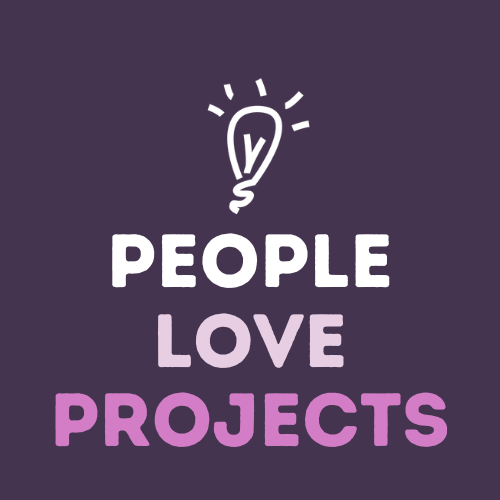When you work with clients, their projects become your projects.
And when you’re consumed with helping others achieve their big goals, you don’t have much time and energy to accomplish your own.
Of course, it’s natural for your paid work to take priority. After all, there is rent to pay and mouths to feed.
But often when we put off the things we really want to accomplish (and accomplish well), the lack of progress toward our goals leaves us feeling sad and disappointed. Like we’re wasting time by not doing something we really want to do.
Basically, it sucks when you don’t feel like you’re progressing how you planned.
But rather than let another year go by — where your important goals and personal projects get pushed aside — let’s take a look at 10 tried-and-tested techniques for making more significant progress.
1. Give yourself permission to start before you feel ready
Prioritizing our own projects can be challenging.
There’s always something else we could be doing. Or “one more thing” we might need before we start. Not to mention the fear that we’ll make the wrong moves and end up failing.
But, predictably, these perfectionist tendencies can only be conquered with one thing: action.
So deliberate, consistent practice (and the permission to be imperfect) is what will produce real progress toward your goals.
Allow yourself to start before you feel ready — making sure you stay flexible and willing to adjust your action plan as needed.
2. Shift your perspective: “Have to” vs. “Get to”
“You can build a work life around deadlines. You can procrastinate, pay the late fines and push through the last minute emergencies because you need all of that in order to get to ‘have to’ mode. Or, you can follow the path of the most productive and happy people you know. By redefining the work you’ve chosen to do as something you get to do.”
– Seth Godin
If you’ve been struggling to start a new project (or make a decision about what to do next), consider reframing it as something you “get to do” rather than “have to do.”
This mindset shift can transform the way you see your work and propel you from a state of procrastination into one of focused action.
3. Use a simple system to move past the “idea phase”
The overwhelm involved with starting a new project can be paralyzing — and it’s often a result of the endless stream of other “amazing” ideas that bombard our thoughts when we’re trying to decide what to do next.
This is where a system for capturing your ideas becomes invaluable.
Simple systems improve the way you work and are essential for making consistent progress toward your goals.
If you’re getting stuck with idea overload, consider creating a Possible Futures folder (h/t Derek Sivers) to collect all your ideas. This can be digital, or in a notebook. Just make sure its the same place all the time. Then whenever you have your next idea, you have a way to capture it, and you can come back to it at later date.
4. Embrace smaller (more effective) steps
“When making plans, think big. When making progress, think small.”
– James Clear
Ever stalled on a new project because it felt too big to achieve? I have (many times).
Usually, it’s because I’m so focused on how long something will take or how much more there’s still to do, and I give up before I even begin.
Big projects need to be broken into small parts in order to feel doable.
I’m now in the habit of “drilling down” into each task I set for myself. My goal is to make it as small as possible so it becomes remarkably easier to start and finish.
I also avoid giving myself large chunks of time to “focus” on my project, because I’ve found that restriction — not freedom — with my time frames works better for me.
Shorter time frames + smaller tasks = faster progress.
Try it!
5. Don’t start with “why” … start with “why not”
“We have more ability than willpower, and it is often an excuse to ourselves that we imagine that things are impossible.”
– François de La Rochefoucauld
When it comes to self-management, a little self-awareness goes a long way.
So before I begin a new project, I like to list out all of the things I might use as excuses for not getting started (or being able to finish). By identifying and acknowledging them, they lose a little bit of their power.
Diving deeper into your excuses can reveal the real reasons you aren’t making your project a priority or achieving the progress you want.
Plus, once your excuses are exposed, you can work out how to eliminate them.
Arming yourself against these potentially crippling roadblocks will ensure an easier time pushing past them when they do inevitably pop up throughout your project.
6. Visualize your finished project
A well-designed project has an effective action plan. Something that can provide clear direction and prompt your next steps.
One of the easiest ways to create a project plan is to work backwards from your end goal.
You have to know what you want to accomplish before you can figure out how you’re going to accomplish it.
Having this visible end goal doesn’t mean your strategy or approach can’t change along the way.
But it does mean you will always have a destination to aim for.
7. Focus on the first step, first
I’m a sucker for the planning stage of any project. I love thinking through all of the things that need to get done and putting them in their correct order of operations.
For me, that’s the easy part.
But sometimes, once I have my big, fancy plan, I get to the “taking action” part and I freeze. All I can think about is how much there is to do and how I’m not quite ready to tackle that last task on the list.
This kind of mental overload is why it’s so important to only focus on what the next step is.
Your project plan is important to have because it keeps you on track and provides your course of action. But if you allow yourself to get lost in the enormity of your to-do list, procrastination is bound to set in.
When you want to make progress, focus on the first step, first. Ignore the rest.
8. Answer these four questions to pinpoint your priority
“You are either consciously saying no to the things that don’t matter or you are unconsciously saying no to the things that do.”
– Rory Vaden
If you can’t decide what to do first, consider running your tasks through a “focus funnel.”
I learned this technique from Rory Vaden, author of the book Procrastinate on Purpose.
A focus funnel is a tool to help ensure that — as much as possible — you’re always spending time on your next most significant thing.
Pick a task on your project list (perhaps one you’ve been putting off) and work your way through these four questions:
- Is this task something I can live without? This stage of the funnel is about elimination and giving yourself permission to ignore certain tasks.
- Can I systematize this task? This stage is about automation and giving yourself permission to invest in a system that can help get this done more efficiently.
- Can someone else perform this task? Here is where you can consider delegation and giving yourself permission to be imperfect.
- Can this wait until later? This is the stage where you can choose (yes, choose) to procrastinate and give yourself permission to put something off — until you’re actually ready to do it.
If you’ve gotten to the end of the funnel and answered “no” to all of the questions, then you have established a priority. It is the next most significant thing on your list.
Concentrate completely on that task until you accomplish it. Treat everything else as a distraction.
9. Practice “just in time” learning
I don’t know about you, but the projects I truly want to work on are usually ones that require a new skill set or some additional knowledge.
And while I used to try to learn everything all at once (a wonderful way to dive head first into procrastination), I have since started matching what I learn to the task at hand.
It’s called “just in time” learning. In a nutshell, you align your knowledge and skill development with your next most significant task, so you can use what you learn immediately in your work.
The goal is to give priority to the thing you need to learn now, not something that might be helpful a month or even a week later.
10. Hold yourself accountable
Building in some accountability is a super effective way to start and stay on track with a new project.
But it’s important to note that the type of accountability you choose can make all of the difference.
- Do you thrive off of peer-to-peer accountability? Is it easier for you to connect and problem-solve with someone who is in the trenches with you?
- Do you respond better to paid accountability? Is it more effective for you to have some skin in the game and hire a coach?
- Do you crave specific guidance from someone who’s already done what you want to do? Can you find a mentor who can help shed some light and evaluate your ideas?
- Do you need to use your family members to hold you to your word? Will tying it to your personal life make it more meaningful?
I know I need a “higher line” for accountability to really work, so finding a mentor or coach has always yielded the best results for me.
But you could be different.
Think about what’s worked for you in the past (and more importantly, what hasn’t).
Then consider what style of accountability will benefit you the most as you work through your next project.
Want to ship something significant together?
If you’re interested in taking more action on your personal and business projects (and would like a proven framework to make “doing the work” easier to navigate) grab my free guide below:



